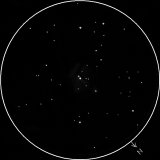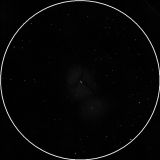
| MESSIER 20 |
|---|
RA: |
18h 02m 42s |
|
DEC: |
-22° 58' 00'' |
|
Type: |
Emission nebula |
|
NGC: |
6514 |
|
Magnitude: |
6.30 |
|
Surface brightness : |
13.5 |
|
Apparent dimensions : |
28'x28' |
|
Distance: |
5,200 ly |
|
Charles Messier discovered this object on June 5, 1764, and described it as a cluster of stars of 8th to 9th magnitude, enveloped in nebulosity. The Trifid Nebula M20 is famous for its three-lobed appearance. This may have caused William Herschel, who normally carefully avoided to number Messier's objects in his catalog, to assign four different numbers to parts of this nebula: H IV.41 (cataloged May 26, 1786) and H V.10, H V.11, H V.12 (dated July 12, 1784). That he numbered this object at all may have its reason in the fact that Messier merely described it as 'Cluster of Stars.' The name 'Trifid' was first used by John Herschel to describe this nebula. The red emission nebula with its young star cluster near its center is surrounded by a blue reflection nebula which is particularly conspicuous to the northern end. The nebula's distance is rather uncertain, with values between 2,200 light years and about 7,600 light years. In the sky, the Trifid nebula M20 is situated roughly 2 degrees northwest of the larger Lagoon Nebula M8, so that both nebulae form a nice target for wide field observations. It is even closer to the open cluster M21 and shows up in the upper left edge of our M21 image. |
||
Other sketches |
|||||
 |
|||||
Messier 20 (June 06). |
|||||
VEDRAN VRHOVAC© 2006.-2007. |
